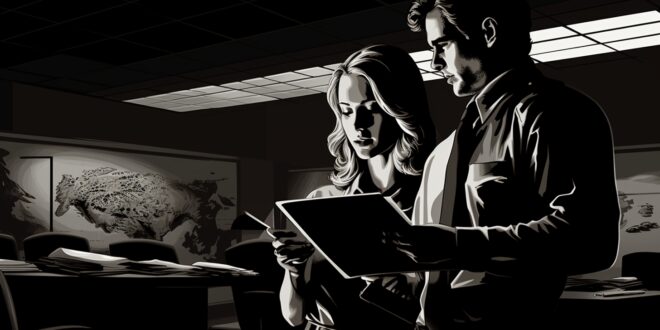The CIA’s Operation CHAOS was a covert program that ran during one of the most tumultuous periods in the United States. And while its name might suggest disorder and confusion, its objectives and methods were calculated and deliberate.
The Central Intelligence Agency has been the epicenter of the United States’ efforts to gather intelligence and maintain security for decades. However, not all its endeavors are known to the general public.
Among these obscured pages of history is the CIA’s Operation CHAOS. Its primary goal was to monitor and influence the anti-Vietnam War movement and other activist groups during the late 1960s and early 1970s.
But why would America’s premier intelligence agency turn its gaze inward, focusing not on external threats but on its own citizens? As you’ll discover, the answers to this question reveal the intersections of national security, political paranoia, and civil rights.
Origins of the Operation
In the late 1960s, America was a nation in flux. Protests against the Vietnam War gained momentum, civil rights movements were in full swing, and counterculture flourished.
In this volatile environment, the CIA’s Operation CHAOS was born. Initiated under the presidency of Lyndon B. Johnson in 1967, the operation was a response to growing concerns about the influence of foreign agents on domestic protests.
The objective was to uncover potential ties between anti-war activists and foreign governments. It also aimed to determine whether these groups received foreign support to undermine the U.S. government.
The CIA Turns Inward
Traditionally tasked with monitoring foreign threats, the CIA experienced a significant shift in focus during the late 1960s. The organization directed its formidable resources inward toward American citizens.
It was a move that marked a deviation from its established mandate. This uncharted territory raised many ethical and legal questions, igniting controversy.
An Encroachment of Civil Liberties
Critics vehemently argued that the CIA’s Operation CHAOS wasn’t just an overstepping of boundaries. It was a blatant encroachment on American civil liberties.
The operation employed covert tactics to gather intelligence on the burgeoning anti-war movement and other leftist organizations. These tactics were extensive and invasive.
They usually involved wiretapping, mail opening, and the strategic infiltration of activist groups. It was all part of the agency’s repertoire during this operation.
Sowing Discord
The scope of the operation was staggering. For seven years, from 1967 to 1974, the CIA amassed files on approximately 7,200 Americans and scrutinized as many as 1,000 groups. The agency actively tried to sow discord within these groups by creating internal conflicts.
The CIA’s Operation CHAOS didn’t discriminate. It infiltrated anti-war activists, civil rights organizations, feminist groups, and socialist party activities.
The objective was clear: unearth potential subversive elements within these groups and identify links to foreign governments. The concern at the time was that foreign entities orchestrated activist movements aimed to destabilize the United States.
The Extent of Surveillance
As the operation unfolded, the extent of the surveillance became increasingly expansive. It scrutinized thousands of Americans and infiltrated hundreds of groups.
The CIA’s Operation CHAOS didn’t limit itself to anti-war activists. Multiple other groups that were viewed as potentially having the ability to cause “trouble” were watched.
This extensive intelligence-gathering raised alarm bells about the potential abuse of power and infringing on citizens’ right to privacy and free speech.
Revelations and Repercussions
It was 1974 when Pulitzer Prize-winning investigative journalist Seymour Hersh highlighted the operation’s undercover activities. He did it through a groundbreaking New York Times article, lifting the cloak of secrecy surrounding the CIA’s Operation CHAOS.
Hersh’s revelation sent shockwaves through the nation. It uncovered a narrative of espionage and surveillance that had infiltrated the lives of thousands of Americans.
This explosive disclosure sparked public outrage and a demand for accountability. In response, Congress initiated a series of investigations, with the Church Committee standing out as the most notable.
Senator Frank Church, the committee’s namesake, led this group. Their task involved conducting a comprehensive review of abuses by intelligence agencies, encompassing those by the CIA, FBI, and NSA.
The Consequences of the Investigations
Consequently, Congress passed the Foreign Intelligence Surveillance Act (FISA) in 1978. It established a legal framework for electronic surveillance and reinforced safeguards against intelligence abuses.
The scrutiny also resulted in the creation of the Senate and House Intelligence Committees. They provide ongoing oversight of intelligence agencies to prevent future abuses.
Echoes in Modern Times
Decades have passed since the CIA’s Operation CHAOS was active. But its legacy continues to influence discussions around civil liberties, government surveillance, and national security.
In an era where technology enables unprecedented levels of surveillance, the questions raised by Operation CHAOS remain relevant. How do we balance the need for security with protecting individual rights? To what extent should intelligence agencies be allowed to monitor their citizens?
The CIA’s Operation CHAOS is a stark reminder of the fine line between safeguarding national interests and infringing civil liberties.
The operation aimed at protecting national security. However, the methods employed and the breadth of surveillance conducted sparked necessary conversations about the limits of government power.
In revisiting this chapter of American history, we also reflect on the enduring tension between security and freedom. We learn to value the importance of vigilance in protecting the democratic principles we hold dear.
 Eurasia Press & News
Eurasia Press & News


